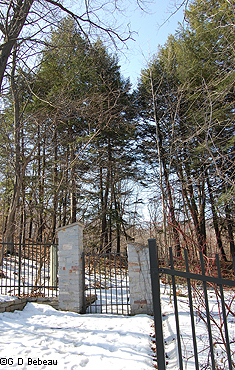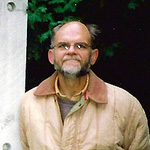
The Friends of the Wildflower Garden
Eloise Butler Wildflower Garden
“Heritage Trees in the Garden”
The Minneapolis Heritage Tree Program
The main text of this article was written by former Gardener Cary George. Several changes to the tree list have occurred since and these are introduced at the end of the article.

The Minneapolis Heritage Tree Program has been in existence for many years; however, I would guess that few citizens are aware of it. Primarily it recognizes the largest tree of each species known to exist within the city limits of Minneapolis.
A smaller but no less important category of Heritage Trees includes those known to have cultural and historical significance. An example of the latter category is the towering Bur oak (Quercus macrocarpa) located between Hwy. 55 and Glenwood Ave on Wirth Parkway opposite the old Loring Cascade (a man-made outcropping of rock that once was a waterfall). This bur oak was selected by former Park Board Superintendent David Fisher as the Park Board’s official logo. While the list of trees for the Heritage Tree Program is quite extensive, only four trees appear on the list for historical or cultural reasons. Most have been selected for size.
Trees of historical significance can honor a community leader, an event in the city’s history or virtually anything that has had impact on the development of Minneapolis. For example, a possible candidate might be the Winterberry (Ilex vericillata) planted in honor of Ken Avery upon his retirement as curator of the Eloise Butler Wildflower Garden. It seems to me this category has been sorely lacking nominations. The election, retirement or death of prominent figures in Minneapolis’ cultural, educational or social life all could make good candidates for tree plantings. Trees planted as dedications of schools, libraries, really any public building or landscape also might be noted with a heritage designation.
The Eloise Butler Wildflower Garden has nine Heritage trees noted for their champion size although interestingly none are listed for cultural or historical reasons, including the white oak that commemorated the curatorship of Eloise Butler (located in front of the Martha Crone Shelter behind the memorial plaque).


The large number of nominations within the Garden is due both to our extensive surveying of every tree and shrub and the very nature of a wild botanical garden with representations on nearly every tree and shrub species in hardiness zones 3-4.
The key to making meaningful additions to the Heritage Tree Program will be focusing on the trees in your neighborhood (in Minneapolis only); yards, parks, railroad right-of-ways or wild areas. Look around. Arm yourself with a good tree guide. The Stokes Series and the Peterson Guides are both excellent and easy to use.
Many tree species are not on the current Heritage list, and many of the current listings are relatively small in size for the species, so there are good opportunities for making additions.
The Park Board Forestry division would like to have more citizen input, so don't hesitate to call or write if you need help with identification in order to nominate a Heritage Tree.


Eleven Heritage Trees are listed for the Garden as of 2018:
- MOUNTAIN MAPLE (Acer spicatum) - west trail near station #12 - Champion size, 28.5 points.
- STRIPED MAPLE (Acer pensylvanicum) - west trail near station 12 - Champion size, 68.25 points.
- YELLOW BIRCH (Betula alleghaniensis) wetland trail - Champion Size, 86 points.
- WITCH HAZEL (Hamamelis virginiana) east trail near station 31 - Champion size, 28.5 points.
- BIG TOOTH ASPEN (Populus grandidentata) just SE of the Garden entrance up a slight hill. Champion size, 94 points.
- AMERICAN WILD PLUM (Prunus americana) - Prairie Garden, first hillside - Champion size, 60 points.
- BLACK CHERRY (Prunus serotina) - just inside north gate - Champion size, 137.5 points.
- WHITE OAK (Quercus alba) - west trail near station 21 - Champion size, 187 points.
- SIBERIAN CRABAPPLE - (Malus baccata) - west trail near station #14 - Champion size, 89 points.
- CANADIAN HEMLOCK (Tsuga canadensis)- inside north gate - Champion size, 173 points.
- CANADIAN HEMLOCK (Tsuga canadensis)- Between stations 16 and 17 - Significant size, 158 points.
In previous years the following three trees were on Cary George's list but are no longer on the Heritage Tree List, replaced by newer entries, except the Ponderosa Pine which has been dropped entirely from the list.
- BLACK WALNUT (Juglans nigra) - West trail near station #16
- JACK PINE (Pinus banksiana) - southeast of the front gate.
- PONDEROSA PINE (Pinus ponderosa) - Prairie Garden, north side

*Cary George was Gardener at the Eloise Butler Wildflower Garden from 1987 through 2003. Cary was the fourth person to be charge of the Garden since its founding. This article was originally published in The Fringed Gentian™, Winter 2000, Vol. 48 No. 1.